Last updated on
Because the size of your master closet can significantly impact your daily routine, this article presents a comprehensive guide detailing dimensions and layout options for various types of walk-in closets.
Key takeaways:
- Walk-in closet dimensions: Aim for a depth of 24 inches and a width of 7 feet.
- Consider your wardrobe size and composition when determining measurements.
- Walk-in closet size options: Standard (4×4), medium (6×8), and large (10×10+).
- Different layouts: Linear, L-shaped, U-shaped, island, peninsula.
- Design considerations: Zone creation, adjustable shelving, drawer systems, double hanging rods, lighting, reflective surfaces.
Ideal Walk-in Closet Dimensions

To optimize your walk-in closet, aim for a depth of at least 24 inches, as this allows room for hanging clothes without them brushing against the back wall. A width of 7 feet accommodates storage along both side walls as well as the back wall, ensuring ample space for a diverse wardrobe.
For a single-sided closet, a minimum width of 4 to 5 feet is essential so that when the door opens, there is clear space opposite the hanging clothes. For a layout facilitating dressing within the closet, you’ll want a minimum dimension of 10 feet by 10 feet to include a bench or seating area.
Remember that these dimensions can be adjusted depending on the available space in your home and your storage needs, but they provide a starting point for creating a functional and comfortable closet environment.
Determining the Measurements for Your Walk-in Closet

Assessing your wardrobe size and composition is crucial; this influences the amount of space you’ll need. Aim for at least 24 inches deep for hanging clothes. For a comfortable walk-through, allocate a minimum of 36 inches of clear passageway. Factor in shelving for shoes and folded garments; typically, 12 inches in depth works for most items.
Consider incorporating varying heights for hanging sections to accommodate different garment lengths, and don’t forget to allocate space for accessories and additional features like an island or a seating area if desired. Remember, proper lighting and mirror placements enhance functionality, making item selection and outfit coordination effortless.
Walk-In Closet Size Options
Standard, small walk-in closets typically measure at least 4 by 4 feet and offer enough space for limited shelving and a hanging area. For a more luxurious feel or to accommodate two users, opt for a medium-sized closet, often around 6 by 8 feet, incorporating more hanging sections, shelves, and drawers.
Large walk-in closets are spacious, generally at least 10 by 10 feet, providing ample room for a center island, a seating area, and varied storage solutions, catering to expansive wardrobe needs and enhancing dressing experiences.
Keep in mind, regardless of size, a layout with a clear, unobstructed central space facilitates comfort and ease of movement.
Layout Space: How Big Should a Walk-In Closet Be?
Selecting the appropriate dimensions for your walk-in closet is essential for both functionality and comfort. A space of at least 7 by 10 feet is recommended to accommodate a two-sided design with ample storage.
For a more luxurious feel or additional features like an island, consider expanding the size to 100 square feet or more, typically around 10 by 10 feet or larger.
Remember the clearance for walking: allow 24 to 30 inches of clear space in the aisles between storage units or the island. If sharing the closet, a width of 7 feet or more allows two people to comfortably use the space at the same time.
For closets intended to house extensive wardrobes or a dressing area, a larger layout might be necessary. In such cases, factor in the room needed for seating, mirrors, and additional storage when planning your space.
Always ensure that the final layout meets your specific needs while providing a harmonious balance between storage and maneuvering space.
Different Types of Walk-in Closet Layouts
Walk-in closets come in various configurations, each tailored to specific needs and space limitations:
1. Linear Layout – Features a single wall of shelves, hanging rods, and storage, ideal for narrower spaces.
2. L-Shaped Layout – Expands storage along two adjoining walls, optimizing corner space and offering a good balance of hanging and shelving options.
3. U-Shaped Layout – Surrounds the user with three walls of storage options, suitable for larger areas and a comprehensive wardrobe organization.
4. Island Layout – Centrally located storage unit, often with drawers or open shelving, providing additional surface area and storage; requires a larger space to maintain walkways.
5. Peninsula Layout – Similar to an island but anchored on one end to a wall, acting as a room divider; a practical solution when an island isn’t feasible.
Each design can be personalized with a mix of storage components—such as shoe racks, drawers, and specialty hangers—to enhance functionality and cater to individual preferences.
Creating a Functional Design for Your Walk-in Closet
Maximizing the utility of your walk-in closet hinges on smart design that caters to your specific needs. Consider the following:
- Zone Creation: Divide your closet into dedicated zones based on clothing type or function, facilitating an organized and efficient layout.
- Adjustable Shelving: Implement adjustable shelves to easily accommodate varying heights of items and seasonal wardrobe changes.
- Drawer and Basket Systems: Incorporate drawers and slide-out baskets to neatly store smaller items and maintain visibility and accessibility.
- Double Hanging Rods: Use double hanging rods to efficiently utilize vertical space for shirts, blouses, and pants.
- Accessible Design: Ensure that frequently used items are within easy reach while lesser-used items are stored higher up or in less accessible areas.
- Lighting: Adequate lighting is essential. Consider adding LED strips or an overhead light to illuminate every part of the closet.
- Reflective Surfaces: Installing mirrors can make spaces feel larger and provide a way to check outfits without leaving the closet.
By adhering to these points, you can create a closet layout that is both functional and tailored to your lifestyle.
Important Considerations for Closet Design
When embarking on the closet design process, several key factors demand careful attention to ensure both functionality and aesthetics are met:
1. Space Planning: Allocate sufficient clearance for ease of movement. Standard walkways should be at least 24 inches wide, with more spacious designs considering 36 inches for a more luxurious feel.
2. Storage Needs: Tailor your closet’s shelving, hanging rods, and drawers to your wardrobe. Double hanging rods are ideal for shirts and pants, while longer garments require full-length hanging space.
3. Lighting: Opt for bright, even lighting to avoid shadows and ensure visibility. LED strips or recessed lights are popular choices that combine efficiency with style.
4. Ventilation: Good airflow prevents mustiness and protects clothing. Consider integrating a vent or a small fan if the closet is enclosed and lacks natural ventilation.
5. Accessibility: Place frequently used items at eye level and within easy reach, and consider pull-down rods or built-in steps for higher storage areas.
6. Flexibility: Adjustable shelves and rods accommodate changing storage needs over time, making your closet adaptable.
7. Materials: Choose durable materials that can withstand daily use while complementing your home’s interior. Consider moisture-resistant options for humid climates.
By keeping these considerations in mind, you lay the foundation for a closet that is both beautifully organized and tailored to your lifestyle.
Building Your Walk-in Closet: Steps To Get Started
Embarking on the construction of a walk-in closet requires a clear plan and a series of deliberate steps:
1. Assess Your Inventory: Begin by evaluating what you own. Sort your clothing, shoes, and accessories to understand the space requirements for each category.
2. Measure Your Space: Precisely measure the room or area earmarked for the closet. Consider the ceiling height as well in your calculations.
3. Design the Layout: Sketch a floor plan, allocating space for hanging items, drawers, shelves, and any additional features you desire. Ensure there is ample room for movement within the closet.
4. Choose Your Materials: Select materials that match your aesthetic preferences and budget. Consider durable options for high-use surfaces.
5. Lighting and Ventilation: Factor in lighting fixtures to illuminate the space effectively and include ventilation solutions to maintain air circulation.
6. Consult a Professional: If the project is complex, it may be worthwhile to consult with a designer or contractor to refine your plan and avoid costly mistakes.
7. Purchasing Supplies and Tools: Once the design is finalized, make a list of all necessary supplies and tools, or discuss these requirements with your hired professional.
8. Building or Installation: Decide whether you’ll undertake the DIY route or employ a professional. For DIY, follow your plan meticulously, adhering to safety protocols. If hiring a professional, oversee the process to keep it aligned with your vision.
9. Customization: Install organizers, hooks, and special features that cater to your unique wardrobe needs.
10. Final Touches: Incorporate personal touches like mirrors, seating, or artwork to make the space feel comfortable and reflective of your style.
Taking each step considerately will ensure your walk-in closet not only meets your practical needs but also becomes a cherished component of your home.
Guide to Hiring a Remodeler for Your Closet
When selecting a remodeler for your closet project, prioritize experience and expertise. Look for professionals with a robust portfolio of closet renovations that showcase their craftsmanship and attention to detail.
- Verify Credentials: Ensure that the remodeler is licensed and insured, protecting you from any liability during the renovation process.
- Read Reviews: Peruse customer testimonials and online reviews to gauge client satisfaction and the quality of the remodeler’s work.
- Get Estimates: Request detailed quotes from multiple contractors to compare pricing, but remember that the cheapest option isn’t always the best.
- Ask About Timelines: Discuss project timelines to ensure they align with your expectations and needs.
- Communication Is Key: Choose someone who communicates well and is responsive to your questions and concerns, as this will be crucial throughout the project.
- Written Agreement: Insist on a written contract that outlines the scope of work, materials to be used, timelines, payment schedule, and any warranties.
By paying close attention to these points, you can partner with a remodeler who will transform your closet space effectively and efficiently.
What to Know Before You Start Designing Your Walk-In Closet
Before embarking on the design process, consider these critical factors:
1. Inventory Assessment: Audit your belongings to ensure that the closet caters to your storage needs. Knowing exactly what you’ll store impacts the design and size requirements.
2. Space Constraints: Measure the area allocated for the closet. Understand the limitations of your space to realistically conceptualize the layout.
3. Budget: Establish a budget early. This will guide your choices of materials, finishes, and add-ons, preventing cost overrun.
4. Lifestyle: Tailor the design to suit your daily routine. If you dress formally often, plan for ample hanging space. For fitness enthusiasts, incorporate sections for workout attire and gear.
5. Lighting: Good lighting is essential. Plan for a combination of natural light, if possible, and artificial light to illuminate every corner and showcase your wardrobe.
6. Ventilation: Ensure proper airflow to maintain a fresh environment and protect your clothing from moisture.
7. Customization Versus Practicality: While customization can be appealing, prioritize practical features that will serve you for years to come.
8. Future Resale: If you plan to sell your home eventually, consider a closet design that appeals to future buyers, striking a balance between personal taste and neutral functionality.
Armed with these insights, you’ll be well-equipped to design a walk-in closet that is both personal and practical.
FAQ
What is a good size for a master closet?
A good size for a master closet typically ranges between 4 to 6 feet wide and 6 to 10 feet long, though larger luxury closets can extend up to 10 feet by 16 feet.
What size is a luxury closet?
A luxury closet typically varies in size from 100 to 200 square feet or more, accommodating custom cabinetry, display areas, and comfortable seating.
What is a standard closet size?
The standard size of a reach-in closet spans roughly 6 feet in length, 8 feet in height, and 24 inches in depth, with an 80-inch high door opening.
How does the size of a master closet affect its organizational efficiency?
The size of a master closet directly affects organizational efficiency as larger spaces allow for more storage solutions and easier access, while smaller closets demand more ingenious use of space to prevent clutter and maintain neatness.
Which design strategies can maximize the use of space in smaller closets?
Implementing customized shelving, using multi-level hangers, incorporating storage boxes, and installing built-in drawers can maximize the use of space in smaller closets.
What factors should you consider when determining the perfect size for your master closet?
When determining the perfect size for your master closet, consider factors such as the size and layout of your master bedroom, your lifestyle needs, your budget, amount of storage required, design aesthetics and ongoing maintenance.
Recap:





